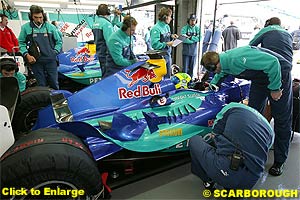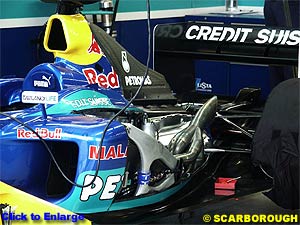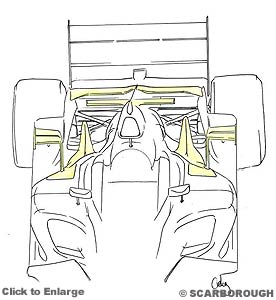
Atlas F1 Technical Writer
The British Grand Prix saw few teams introduce new car updates, but Sauber came with a completely revised package that has, in fact, proved competitive. Atlas F1's Craig Scarborough reviews the Sauber changes, as well as those seen on other cars during last weekend's race, and reviews their performance
Sauber Update
Making the use of the book folded radiators run earlier in the season, the new sidepods are shrunken to an extreme not yet seen on the grid. The sidepod tops slope off rapidly, leaving the exhaust system protruding through a tightly wrapped fairing. Unusually the exhaust fairing is now part of the sidepod and not detachable, while the cooling outlet grills are re-sited to the top of the sidepods. As the sidepods are so much lower, the winglets now have very long struts to support them and now feature two elements to the aerofoil section.
Team by Team
Ferrari
Ferrari arrived at Round 11 with minor revisions to an already familiar layout. In a typically strategic weekend Ferrari advanced their tyre selection runs to the Friday morning session with the threat of afternoon rain. With none falling, extra setup work was done to maximise the Bridgestone tendency to work better when scrubbed, the bug bear of Ferrari's opening laps of recent races.
Once again anticipating afternoon rain, the Ferrari drivers posted slow times in the pre-qualifying sessions, in order to start from a more strategic positioning in the main qualifying session.
In the race itself, following uneventful starts, both cars struggled as the Bridgestones slowly bedded in under cooler conditions, only realising their performance after eight laps. Surprisingly, Ferrari were ready in the pits before their rivals - even more so surprising, as Rubens Barrichello was the first man in for service, although most likely this was a reaction to Barrichello's position in traffic.
The Brazilian once again struggled with the waiting period of the new set of tyres but was able to keep his position. Michael Schumacher was able to run on clear track at length, a benefit of Ferrari's decision to go with a heavier fuel load to give maximum flexibility in uncertain weather.
Following the Safety Car in response to Jarno Trulli's accident, there were again concerns about the time it took for the Bridgestones to regain their performance, however traffic prevented the risk from being realised and the race order was maintained until the end.
Williams
Williams appeared with the sidepods first seen at the French GP and although the team acknowledged the parts had not been track-tested, they were confident in their simulation and wind tunnel data. While the new sidepods also contained radiator changes, none were made to the upright coolers and Williams maintained their traditional mounting.
A trouble free Friday aided their tyre selection, with the instability of qualifying being put down to the wind.
In the race, following unspectacular starts, Juan Pablo Montoya was able to recover positions and finish in the points while Marc Gene made no noticeable impact on the proceedings.
McLaren
It is suggested the grooves allow the disc\pads to warm up and cool down quicker, as the face of the disc is both smaller and vented. This allows the ideal situation where the initial grab is improved (quicker to warm up), and reduce wear through oxidation from overheated disc faces (quicker to cool down). Meanwhile, the internal drillings keep the core of the disc up to temperature. Again, this means the team can run smaller brake ducts to reduce aerodynamic drag.
Friday results of first and fourth left the team in a positive mood while still uncertain as to how much the new car had been an improvement. The form was realised again in qualifying, with Kimi Raikkonen matching the best times in the first two sectors, and being fastest in the third and final timing section. This is thought to be down to McLaren's struggles in slow corners and the resultant change to lighter fuel loads. David Coulthard's P6 grid position was a relative struggle to Raikkonen's pole.
Following an excellent race start, Raikkonen pushed the advantage of Michelin tyres in their initial laps and kept his lead to the first round of stops. He was able to apply pressure on new rubber after each stop, and enjoyed less drop-off towards the end of the stints than had been seen in France.
The Safety Car period, along with the new set of tyres, was Raikkonen's best chance for a renewed challenge against Michael Schumacher's Ferrari but traffic prevented him from pressing the advantage. David Coulthard struggled with Sector 3 throughout the race and came home seventh.
Renault
With Alonso moved to the rear and Jarno Trulli struggling, the team were not filled with optimism. The weekend went from bad to worse with Trulli's dramatic and worrying crash in Bridge, caused by a left rear suspension failure through a highly loaded right hand bend – which resulted with the car digging into the gravel and somersaulting.
Alonso was too quick onto the accident scene and the team was unable to respond to bring him into the pits on such short notice, costing him some much needed strategic advantage.
BAR
BAR decided against debuting expected new aero parts, as testing did not validate the expected gains - though they may still be seen in time for Hockenheim. At Silverstone, the front wing endplates were introduced with a Williams-esque stepped footplate.
Friday showed disappointment as neither race driver was able to maximise the car's apparent speed, and test driver Anthony Davidson had his day's programme interrupted by gearbox failure, suspected to be caused by a broken tooth in one of the engine-manufactured gears.
Sauber
The opening sessions on Friday showed the potential in the weekend's changes as Giancarlo Fisichella utilised the improved balance and grip to set second fastest time. Teammate Felipe Massa was also satisfied, ending the day in tenth, having set his time on used rubber.
The team's joy was short lived, however, when Fisichella's engine failed and as a result Sauber did not run the Italian in qualifying to save the tyres and allow last minute fuel decisions for race day. Massa was able to take part in his run but an incident with the Toyota of Olivier Panis kept the Brazilian back in ninth place.
The drivers' confidence in the cars was confirmed on race day with Fisichella's impressive pace, and a two stop strategy earned him a sixth place finish, even after a delay to top up the nitrogen cylinder feeding the engine pneumatics during the final stop.
Massa also ran strongly but suffered problems engaging first gear during pitstops and finished ninth.
Jaguar
While not seen in the lap times, Jaguar were pleased with the car and the results of their Friday programme, hinting at the strategy of the weekend.
Saturday showed better results, with Mark Webber putting his car ninth on the grid and Christian Klien a few spots behind, in 14th.
Webber's excellent qualifying time and his race start belied what was a two stop fuel load; He fought throughout the race with the other two stoppers to put in a point finish in eighth.
Toyota
Toyota did not arrive at Silverstone with their expected new chassis, instead preferring to test it this week at Jerez. The team are now planning to debut the new chassis at the German GP next weekend, at Hockenheim.
Friday left the team with even more questions, after failing to find a balance in the car's set up for the mix of high and low speed corners, as well as the bumps, which were upsetting the car's balance. Track time was further limited with a gearbox change in the car of Cristiano da Matta.
The problems continued into Saturday, as Olivier Panis was not informed accurately of the position of Felipe Massa's Sauber and inadvertently balked the Brazilian through the Abbey Chicane resulting in Panis' qualifying time being disallowed. The Frenchman's weekend sank lower in the race as his cockpit fire extinguisher went off, forcing him to stop on track.
Jordan
The cold weather and the additional rubber put down by other cars on Friday created a conflict with the data that Jordan had gathered in earlier Silverstone tests, thus leaving the team with no optimal setup found by the end of the day.
Timo Glock suffered a mechanical failure which put him into a dramatic incident and the team was left searching for the cause to ensure the safety of its drivers. The team factory being over the road from the circuit assisted them in researching the problem, and they were confident the problems would not to be repeated. The drivers also suffered with some fading tyres toward the end of their qualifying laps, costing them some pace.
Giorgio Pantano's race was punctuated by two spins - both apparently caused by going too wide in and letting a rear wheel onto the grass. The second incident saw him beached on the gravel and unable to resume the race.
Nick heidfeld's qualifying lap was run on the heaviest fuel load of the grid, probably in anticipation of rain during the race. When this didn't happen, Heidfeld was stuck with initially a heavy fuel load and latterly worn tyres.
Minardi
Predictably, the team struggled to find a setup on a track they had not tested on, at Zsolt Baumgartner's car was the victim of gearbox issues in the morning with an engine change for unrelated problems that evening, with teammate Gianmaria Bruni Bruni also requiring an engine change.
The string of bad luck ran into the race with drive-through penalties for blue flag infringements, an engine failure and a pitlane accident knocking over the refueller.
However, it paled in comparison to the loss of sporting director John Walton, who died on Friday night after suffering three days earlier a severe heart attack. Minardi will be glad to leave Silverstone after their terrible weekend.
Coming just a week after the French Grand Prix, which itself followed closely on the two transatlantic races, Silverstone was not the venue for the usual mid season updates, with only Sauber sporting serious revisions.
 The weekend threatened rain with each afternoon and while none fell during the race, the effects were seen in the Friday setups, the shuffle for Saturday qualifying order, and even in the race day strategies. With rainfall on Thursday and colder temperature throughout the weekend, the climate reinforced the characters of the tyres. Michelin have reversed their familiar trait of being durable, long lasting tyres that work best in hot temperatures. Instead, Bridgestone have assumed that reputation, bringing Michelin closer to the Japanese manufacturer in competitiveness this weekend.
The weekend threatened rain with each afternoon and while none fell during the race, the effects were seen in the Friday setups, the shuffle for Saturday qualifying order, and even in the race day strategies. With rainfall on Thursday and colder temperature throughout the weekend, the climate reinforced the characters of the tyres. Michelin have reversed their familiar trait of being durable, long lasting tyres that work best in hot temperatures. Instead, Bridgestone have assumed that reputation, bringing Michelin closer to the Japanese manufacturer in competitiveness this weekend.
 Sauber's new windtunnel allows the aerodynamics team, lead by Seamus Mullarkey, to investigate new avenues. Having been unable to test their model in yaw or side winds in the commercial tunnel used at Emmen, Sauber now have a cutting edge facility. Silverstone saw the first real result of the tunnel programme with the all new sidepods.
Sauber's new windtunnel allows the aerodynamics team, lead by Seamus Mullarkey, to investigate new avenues. Having been unable to test their model in yaw or side winds in the commercial tunnel used at Emmen, Sauber now have a cutting edge facility. Silverstone saw the first real result of the tunnel programme with the all new sidepods.
 A new shelf wing was also adopted, eschewing the flat broad shape seen in Monaco, following Renault's format of three distinct chord changes to smooth the flow and also prevent sending unwanted vortices to the rear wing. It can be assumed that the revised bodywork both improves the quality of flow to the wing and also improves the drag figures from increased space between the rear wheels. Added to this, the engine received an upgrade from Ferrari and throughout the weekend the drivers commented on how stable the revised car felt as the team's competitiveness improved.
A new shelf wing was also adopted, eschewing the flat broad shape seen in Monaco, following Renault's format of three distinct chord changes to smooth the flow and also prevent sending unwanted vortices to the rear wing. It can be assumed that the revised bodywork both improves the quality of flow to the wing and also improves the drag figures from increased space between the rear wheels. Added to this, the engine received an upgrade from Ferrari and throughout the weekend the drivers commented on how stable the revised car felt as the team's competitiveness improved.
 McLaren continue to explore grooved brake discs with the hopes of capitalising on the increase in initial pedal bite and overall better heat dissipation, which has a knock on effect of allowing the team to run smaller brake ducts.
McLaren continue to explore grooved brake discs with the hopes of capitalising on the increase in initial pedal bite and overall better heat dissipation, which has a knock on effect of allowing the team to run smaller brake ducts.
 Following the revisions seen at the French GP, Renault arrived with only detail changes. Fernando Alonso was struck with throttle problems in the opening Friday session but was able to take part in the afternoon's running. However, his problems continued into Saturday with engine failure prior to qualifying from a suggested failure of the cylinder head. Renault were confident that it was an isolated incident but it still cost the Spaniard 10 positions on the grid.
Following the revisions seen at the French GP, Renault arrived with only detail changes. Fernando Alonso was struck with throttle problems in the opening Friday session but was able to take part in the afternoon's running. However, his problems continued into Saturday with engine failure prior to qualifying from a suggested failure of the cylinder head. Renault were confident that it was an isolated incident but it still cost the Spaniard 10 positions on the grid.
 Saturday ran to plan with increased speed following overnight simulation work and setup changes. However the car's struggle for grip persisted in the race and neither driver attacked beyond the opening laps. Takuma Sato ran on a two stop strategy and Jenson Button on three, and both drivers were disappointed with their results.
Saturday ran to plan with increased speed following overnight simulation work and setup changes. However the car's struggle for grip persisted in the race and neither driver attacked beyond the opening laps. Takuma Sato ran on a two stop strategy and Jenson Button on three, and both drivers were disappointed with their results.
|
Contact the Author Contact the Editor |
Please Contact Us for permission to republish this or any other material from Atlas F1.
|
Volume 10, Issue 28
Atlas F1 Exclusive
Bjorn Wirdheim: Going Places
Ann Bradshaw: Point of View
Articles
Finishing School 2004
2004 British GP Review
2004 British GP Review
Technical Review: Britain 2004
Rain Dance
Stats Center
Qualifying Differentials
SuperStats
Charts Center
Columns
The F1 Insider
Season Strokes
On the Road
Elsewhere in Racing
The Weekly Grapevine
> Homepage |